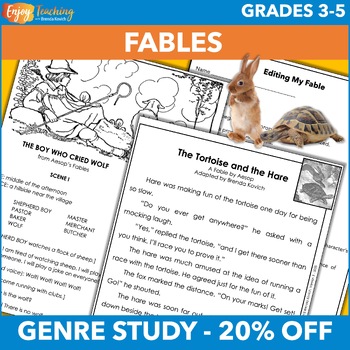Aesop’s Fables Unit & Lesson Plans – Genre Study for 3rd, 4th, 5th Grade
- Zip
- Google Apps™
- Easel Activity

What educators are saying
Products in this Bundle (6)
showing 1-5 of 6 products
Bonus
Description
This fables unit offers a complete reading, writing, speaking, and listening experience! It includes lesson plans, 10 stories with comprehension questions, 7 plays, writing, and compare-contrast activities. You’ll have everything you need to teach your third, fourth, or fifth grade students.
Open the preview to take a closer look at the components.
Lesson Plans
Three weeks of ELA lesson plans are ready to go! You may use them to guide your study of fables. (Open the bonus preview to see the plans.)
10 Aesop’s Fables with Comprehension Questions
Students infer, find word meaning, describe story elements, find the moral, and more. Stories have been adapted for upper elementary reading.
Fables include:
- “The Ants and the Grasshopper”
- “The Boy Who Cried Wolf”
- “The Donkey and the Load of Salt”
- “The Fox and the Crow”
- “The Fox and the Grapes”
- “The Goose and the Golden Eggs”
- “The Miller, His Son, and the Donkey”
- “The Peacock”
- “The Tortoise and the Hare”
- “The Town Mouse and the Country Mouse”
Aesop’s Fables in Drama Form – Seven Printable Plays
Scripts may be used for short skits, readers theater, or full-blown plays – for up to 40 students!
- First, kids learn about structural elements of drama. Two reference guides offer definitions, as well as an annotated example.
- Second, as an exit ticket, students can identify elements in one of the plays.
- Finally, they’re ready to act out some plays.
Materials include:
- Lesson plans
- Elements of drama reference guide
- “The Boy Who Cried Wolf” – seven characters
- “The Crow and the Fox” – three characters
- “The Crow and the Pitcher” – two characters
- “The Miller, His Son, and Their Donkey” – fourteen characters
- “The Pot of Gold” – five characters
- “The Wolf and the Goat” – three characters
- “The Wolf and the Horse” – seven or more characters
The sequence of this unit is carefully sequenced to scaffold kids to narrative
writing success. It teaches specific writing processes that will improve their craft. Students:
- analyze two fables and identify common elements;
- learn rules and practice writing dialogue;
- explore traits associated with various animals;
- consider proverbs choose a moral;
- plan their narratives;
- explore good introductions and conclusions, specific word choice, and transitions;
- draft, revise, and finalize.
Resources include:
- Lesson plans
- Two fables by Aesop, specially adapted for this writing project
- Writing dialogue slideshow (PowerPoint or Google Slides)
- Dialogue reference guide
- Dialogue practice worksheet
- Worksheet for analysis of animals and their traits
- List of proverbs (to help select morals)
- 3 planning sheets
- 1 page of transition terms
- Editing sheet
- Rubric
Comparing and Contrasting Fables with Stories and Plays
Kids compare and contrast three fables, which are each included in two forms: prose (story) and drama (play). They use Venn diagrams and tables to find similarities and differences of:
- different stories told in prose,
- different plays written in drama form, or
- the prose and drama forms of the same fable.
Resources include:
- Lesson plans
- Reference guide – elements of prose and drama
- Venn diagram for comparing two different fables
- Worksheet for evaluating two different fables
- “The Boy Who Cried Wolf” – 1-page story, three-page play, Venn diagram and worksheet
- “The Miller, His Son, and the Donkey” - 1-page story, three-page play, Venn diagram and worksheet
- “The Fox and the Crow” - 1-page story, two-page play, Venn diagram and worksheet
The unit include everything you need for your genre study and more. You will also receive a poster, anchor chart, graphic organizer, and questions.
Enjoy teaching fables to your third, fourth, or fifth grade students!
Brenda Kovich





